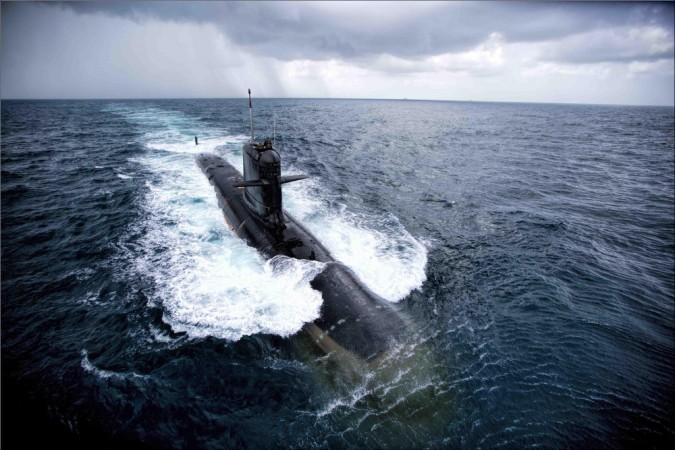Indian Navy is just weeks away before it gets one of the world's stealthiest submarines: the INS Kalvari, the first of the six French-made Scorpene-class submarines on order. The commissioning of the attack submarine later this month comes at a time when India races to upgrade its underwater force as China is rapidly expanding its military presence in the Indian Ocean.
The INS Kalvari is part of the Rs. 23,652 crore ($3.7 billion) "Project-75" awarded in 2005 to the state-owned defence shipyard Mazagon Dock Shipbuilders Ltd. in Mumbai and France's Naval Group. Subhash Bhamre, the minister of state in the Ministry of Defence, said in July that the first of the six submarines under construction in the shipyard was scheduled to be delivered in August while the second submarine, INS Khanderi, would be delivered in December.
Launched in October 2015, the INS Kalvari is named after a deep-sea tiger shark. The submarine, which is equipped with a superior stealth technology compared to previous diesel-electric submarines, can launch massive attacks through torpedoes as well as tube launched anti-ship missiles both on the surface of the water and beneath. In May, the INS Kalvari test-fired an underwater torpedo missile for the first time.

The INS Kalvari and other Scorpene-class submarines "can undertake multifarious types of missions typically undertaken by any modern submarine," including "Anti-Surface warfare, Anti-Submarine warfare, Intelligence gathering, Mine Laying, Area Surveillance" and so on, according to the Indian Navy.
India is vulnerable to underwater attack
Due to the Indian Navy's failure to replace retired submarines, the country's underwater fleet has decreased to 13 conventional submarines from 21 since 1996. China, on the other hand, has nearly 60 submarines, including five nuclear-powered attack submarines and 54 diesel-powered attack submarines. According to the Pentagon, the number is expected to grow to between 69 and 78 by 2020.
India, however, is gradually upgrading its submarine force, and the six Scorpenes are just the start for the country. In February 2015, the Indian government approved the construction of six nuclear-powered attack submarines. Last month, the country also initiated another project, worth about 70,000 crore ($10.9 billion), to build six more diesel submarines.

India is also reportedly developing an underwater nuclear deterrence. The country's first nuclear-powered submarine, which is part of a program to build at least three such vessels, was commissioned in 2016. The other nuclear-powered submarine was leased from Russia for 10 years in 2012.
However, for effective deterrence against China and Pakistan, the Indian Navy reportedly needs to have at least 18 diesel-electric submarines, six nuclear-powered attack submarines (called SSNs) and four nuclear-powered submarines with long-range nuclear-tipped missiles (SSBNs).
China is not a 'serious threat' yet
The Indian effort to modernise and significantly increase the size of its own submarine fleet is mainly driven by China's increasing naval activity in the Indian Ocean.
The opening of China's first naval base in Djibouti at the western end of the Indian Ocean in July and regular visits by the PLA Navy to the port of Karachi in Pakistan have also raised concerns among Indian planners amid a border dispute stand-off between India and China in Bhutan.
Despite China's constant attempts to grow its regional capabilities, some analysts still believe that China is still years away from posing a serious threat to India in the Indian Ocean, thanks to a geographical advantage.
To enter the Indian Ocean, the Chinese Navy needs to pass through the Strait of Malacca, a narrow stretch of water between the Malay Peninsula and the Indonesian island of Sumatra. This is an area, which is constantly under observation by the Indian surveillance planes deployed to Andaman & Nicobar Islands.
"Simple geography gives India a huge strategic advantage in the Indian Ocean," David Brewster, a senior research fellow with the National Security College at the Australian National University in Canberra, told Bloomberg. "And although China has been sending in submarines, you have to understand they are probably decades away from being able to seriously challenge India there, especially while the United States is present."











